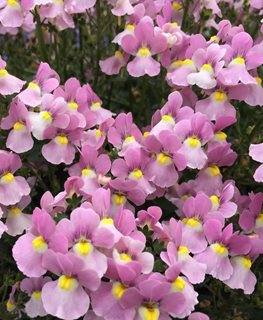Nemesia: A Care & Growing Guide
Brighten up your spring garden with this vibrantly colored, cool-season flower.
Aromance® Mulberry nemesia. Photo by Proven Winners
Flowering annuals that can handle the chill of early spring are a breath of fresh air after a long winter, bringing instant color to a garden just beginning to come to life. One early-season annual that is often overlooked is nemesia, a cottage garden favorite with dainty snapdragon-like blooms in a brilliant array of jewel-toned colors.
Growing little more than a foot tall, this compact plant is perfect for use in the front of the border or to add a pop of color to containers and hanging baskets. Nemesias also look beautiful planted among spring daffodils and tulips, with their colorful blossoms obscuring the fading foliage after the bulbs have finished flowering.
Although nemesia is typically at its peak from spring through early summer, it will often remain in bloom until frost in climates with cool summers, giving you a long season of interest. What’s more, some newer varieties of nemesia have been bred for greater heat tolerance, so you don’t have to worry about them withering when the temperatures rise.
On this page: Basics | Planting | Care | Varieties | Companion Plants for Nemesia
On this page:
BASICS
Botanical name:
Nemesia spp. and hybrids
Common names:
Nemesia, cape jewels, pouch nemesia
Origin:
Native to South Africa
Zone:
Tender perennial in Zones 9 to 11; usually grown as an annual
Exposure:
Full sun to partial shade
Bloom time:
Spring to early summer
Height/spread:
6 to 18 inches tall and wide
Flower colors:
Two-lipped tubular flowers bloom in almost every color except green, including white, yellow, orange, pink, red, purple, and blue. Bicolored varieties, with upper and lower lips of different colors, are also common.
Special attributes:
- Attracts bees and butterflies
- Highly fragrant flowers
- Requires minimal pruning
- Pest and disease resistant
Are nemesia flowers toxic?
The flowers are non-toxic to people and pets, but consuming them is not recommended because they can cause digestive upset if eaten in large quantities.
PLANTING NEMESIA

Sunsatia® Blood Orange nemesia. Photo by Proven Winners
Where to plant:
For the best performance, plant in a location that receives full sun (a minimum of 6 to 8 hours daily). As the summer heat intensifies, consider moving plants to a spot sheltered from hot afternoon sun to prolong their bloom period.
When to plant:
In spring or early summer, after the danger of frost has passed. In frost-free climates, nemesia can also be planted in the fall and grown as a winter annual.
Soil:
Grow in fertile, evenly moist, well-drained soil. If you have heavy clay soil, amend with organic matter to improve drainage (see Garden Soil 101). Nemesias don’t like to get wet feet and can develop root and stem rot if planted in soil that drains poorly.
How to plant:
You can often find potted nursery starts of nemesia at local garden centers in early spring. To plant, dig a hole about the same width and depth as the root ball and place the plant in the hole with the top of the root ball level with the soil surface. Backfill with soil, and tamp lightly. To ensure good air circulation, space plants at least 6 inches apart, depending on their width at maturity.
Growing from seed:
Nemesia is relatively easy to grow from seed, which can be sown directly in the garden after the soil has warmed up in spring or germinated indoors in seed trays six to eight weeks before the last frost date (see How to Grow Plants from Seeds). Nemesia seeds will usually sprout within one to two weeks when kept at temperatures of 65 to 70 degrees F and in a brightly lit location.
Planting in containers:
Plant nemesia in a high-quality, all-purpose potting mix, making sure to use a container with drainage holes so the roots won’t get waterlogged. For the best blooms, mix a slow-release fertilizer into the soil at planting time.
NEMESIA CARE
Watering:
Keep the soil evenly moist, especially during the heat of the summer, but don’t let it become soggy, which can quickly lead to root rot. Applying a layer of organic mulch around your plants will help retain soil moisture and reduce watering frequency. Water container-grown plants whenever the top 2 inches of soil feel dry to the touch.
Amendments and fertilizer:
Apply a light top dressing of compost or a slow-release granular fertilizer at planting time. Potted plants may need supplemental feedings throughout the bloom season with a water-soluble plant food. If your plants go dormant during the summer, withhold feeding until the cooler temperatures of fall arrive.
Pruning and deadheading:
Although pruning is unnecessary, you can pinch plants back if you want a fuller appearance. Flowers are self-cleaning, sparing you the chore of deadheading.
Common pests and problems:
No serious insect or disease problems, but root rot may occur in poorly drained, soggy soils. Also watch out for powdery mildew, which can be avoided by providing good air circulation between plants.
Get more nemesia growing tips: Succeeding with Nemesia, from Proven Winners.
POPULAR NEMESIA VARIETIES
COMPANION PLANTS FOR NEMESIA
In container plantings, nemesia blends well with many other annuals, especially as a filler or spiller component. Just be sure to choose plants that have the same exposure and water requirements. Here are some suggestions:
- Plant a hanging basket with pansies, trailing nemesias (such as Sunsatia® varieties), and African daisies to bring early color to the spring garden.
- Use nemesia as a filler along with taller plants such as angelonia, coleus, geraniums, or ornamental grasses.
- Combine nemesia with other plants with small, dainty flowers, such as calibrachoa, trailing lobelia, sweet alyssum, and verbena, to create a living bouquet of petite blooms.
For more ideas, see these nemesia container recipes from Proven Winners.
RELATED:
Annual Flowers





